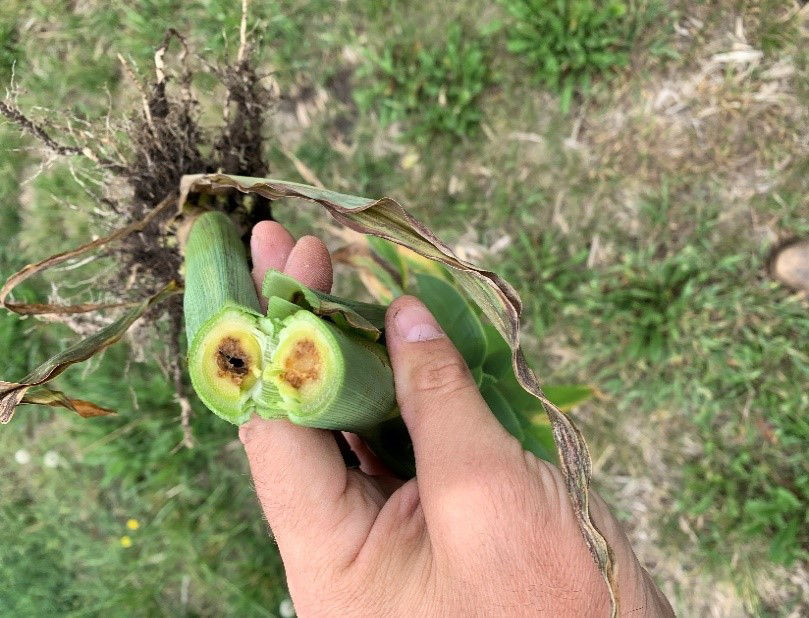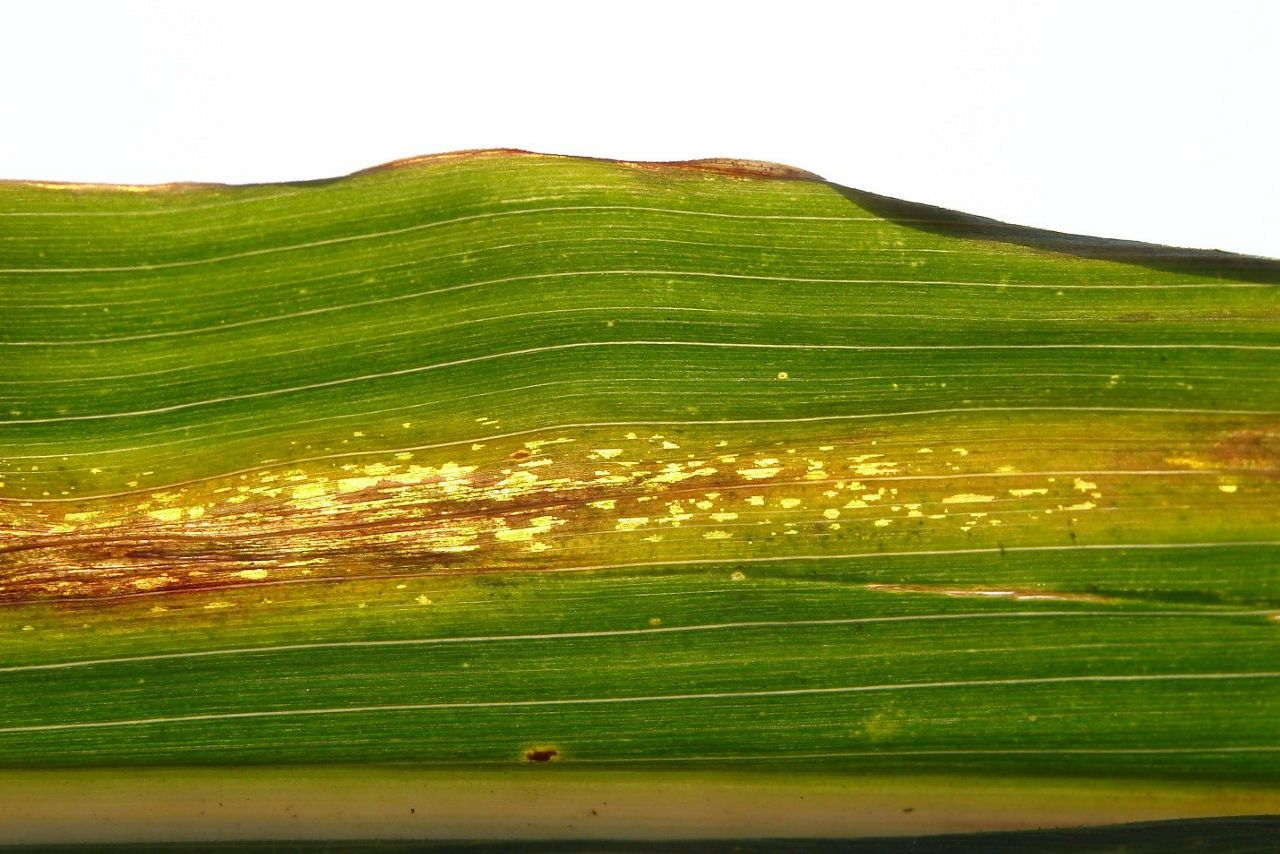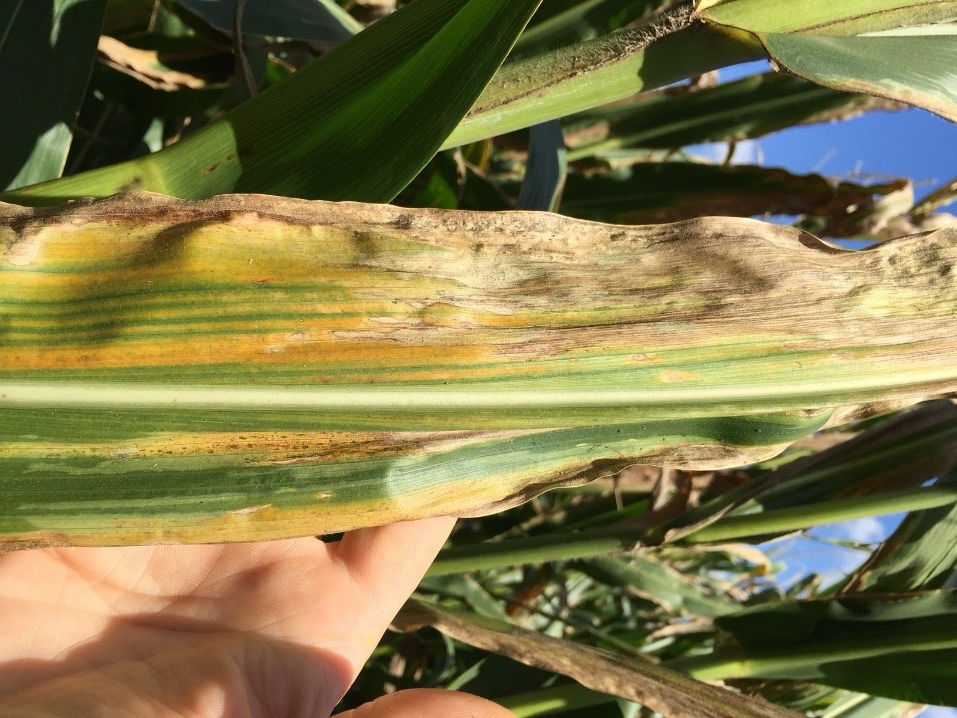5 MIN READ
Goss’s Bacterial Wilt and Blight: Early Systemic and Late Blight Symptoms
July 7, 2022
What to Consider
Goss’s bacterial wilt and blight is a persistent and economically significant disease of dent, food-grade, sweet corn, and popcorn. 1 The disease is observed in two distinct phases: a less frequent vascular wilt that appears earlier in the season, and a leaf blight that appears mid-season. Symptoms of Goss’s wilt can be confused with drought, nutrient deficiency, and other foliar diseases such as northern corn leaf blight. As it is a bacterial disease, fungicide applications will not control or prevent infection.
Early-season Symptoms
- Systemic infection may occur resulting in wilting and plant death.
- Infection moves throughout water-conducting tissues in plants.
- Orange to brown discoloration of vascular tissues (Figure 1) followed by wilting and plant death.1,2

Mid-season Symptoms
- Long, gray-green water-soaked streaks with wavy margins.
- Smaller, darker water-soaked lesions (freckles) that luminance when backlite by holding leaf up against the sun. (Figure 2).

- Lesions ooze bacteria laden droplets in the morning.
- Crystalline sheen on leaves as droplets dry.
- Lesions fade to a tan color and may blight large areas of leaves (Figure 3).

Infection Sources. The bacterium Clavibacter michiganensis subsp. nebraskensis, overwinters in crop residue and enters plants through wounds created by injuries from wind, sand, or hail. The disease can spread from one field to another through displacement of crop residue. Within fields, initial infection can occur as rain or irrigation water splashes bacteria from infected crop residue onto corn plants.
Conditions Favoring Disease. Reduced tillage in conjunction with continuous corn allows corn residue to remain intact and provides an overwintering place for bacteria. Low levels of Goss’s wilt can go undetected until environmental conditions (80° F temperatures) favor development of the disease.1 During hot, dry weather, Goss’s wilt symptoms are harder to distinguish from drought stress and other disorders. Goss’s wilt can survive in and on seed; however, transmission to and from seed to seedling is very low.3 Seed conditioning processes remove naturally occurring, heavily infected seeds from commercial seed lots.
Yield Impact
In areas where management options are limited, Goss’s wilt has the potential to be a difficult disease to control. Goss’s wilt may cause significant yield loss during years with favorable conditions and in fields planted with susceptible cultivars.
Systemic infections may start early but can cause plant death during any time during the season. Losses from systemic infections can get up to 50 percent during years when conditions are favorable in fields with susceptible cultivars.1 A 60 bu/acre yield loss has been reported for bacterial wilt and leaf blight.2 There are no reliable in-season control measures recommended and the best management of an existing infection is to assess it and plan for the next season.
Management
Goss’s wilt management should center around crop rotation, tillage practices, and weed management. Corn seed products with tolerance to Goss’s Wilt can be selected for fields with a history of the disease.
Rotating out of corn for two or more years can provide good control of Goss’s wilt by allowing infected residue to degrade and bacterial populations to diminish before corn is planted again. Non-host crops include alfalfa, oats, wheat, soybeans, and sugar beets.
Any tillage operation which buries infected crop residue, encouraging decomposition, can be effective in reducing bacterial populations and the rate of new infection. However, this is not a practical option in conservation tillage systems.
Grass weeds including green foxtail, barnyard grass, and shattercane can also serve as hosts for the bacteria and be a reservoir from which bacteria spread to corn plants.2 Controlling weeds can help limit sources of inoculum.
Laboratory testing can confirm the presence of Goss’s wilt in fields. Samples should include completed forms and be packaged according to laboratory instructions. Include information that can be useful for a correct diagnosis such as factors that you suspect may have caused symptoms like Goss’s wilt.
In summary, Goss’s wilt has the potential to be a difficult disease to control in-season. Significant loss of yield potential may occur during seasons with favorable environmental conditions. Corn products should be selected to tolerate Goss’s wilt where there has been a history of this disease.
Sources:
1 Jackson, T.A., Harveson, R.M., and Vidaver, A.K. 2007. Goss’s bacterial wilt and leaf blight of corn. University of Nebraska –Lincoln. G1675.
2 Wise, K., Ruhl, G., and Creswell, T.. 2010. Goss’s bacterial wilt and leaf blight. BP-81-W. Purdue University Extension. http://www.btny.purdue.edu .
3 Biddle, J.A., McGee, D.C., and Braun, E.J.. 1990. Seed transmission of Clavibacter michiganense subsp. nebraskense in corn. Plant Disease 74:908-911.
1211_46550